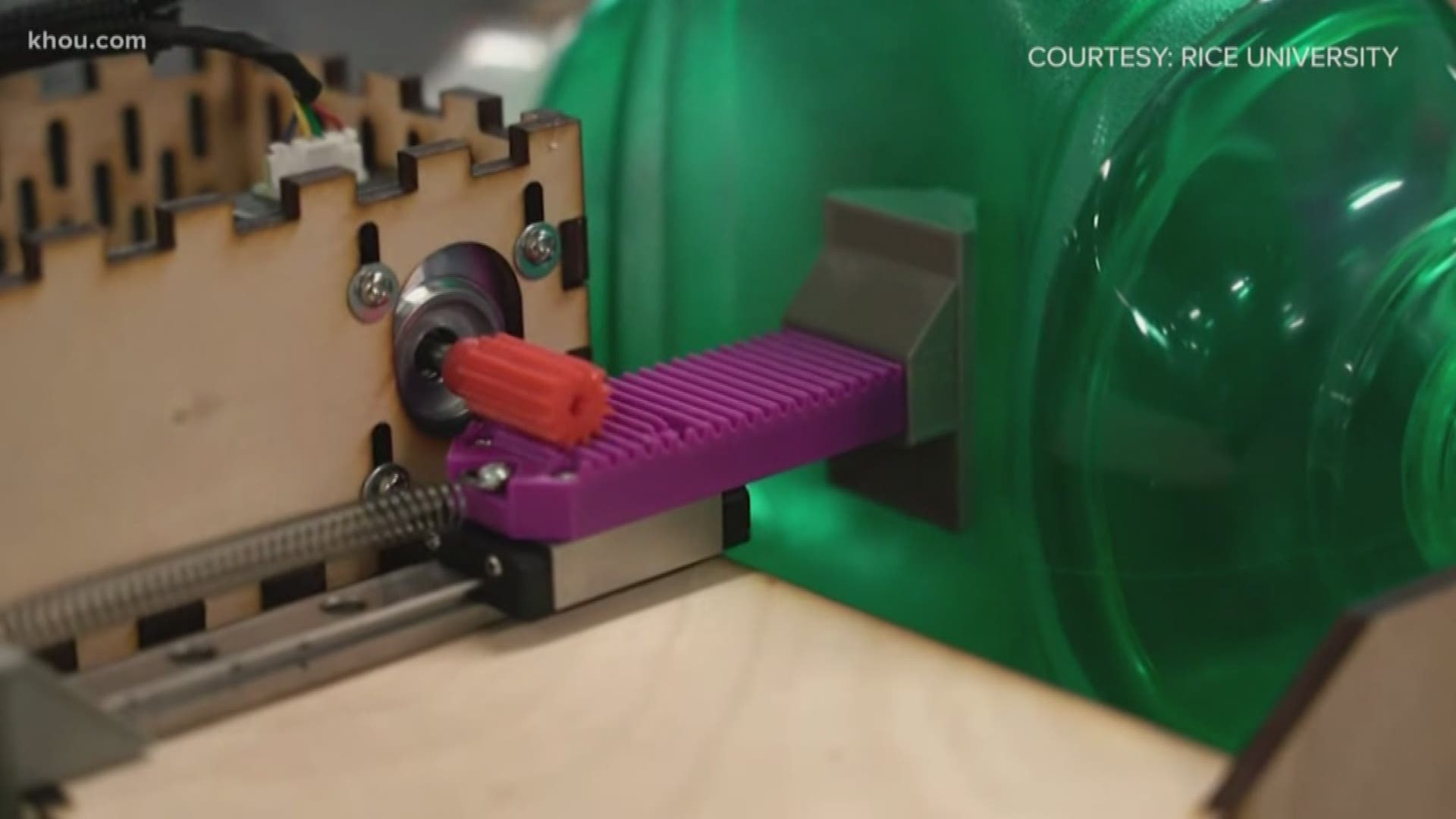HOUSTON — A team from Rice University teamed up with a Canadian company to develop a low-cost ventilator using an automated bag valve mask.
There is a desperate need for ventilators in the U.S. and around the world because of the coronavirus pandemic.
The Rice students used 3D technology and laser-cut parts to come up with the $300 prototype in less than a week. Rice and global health design firm Metric Technologies will share the plans for the ventilator by making them freely available online to anyone in the world.
“The immediate goal is a device that works well enough to keep noncritical COVID-19 patients stable and frees up larger ventilators for more critical patients,” added Amy Kavalewitz, executive director of the engineering department.
Faculty and students went into overdrive several weeks ago, starting with a bag valve mask prototype developed in 2019 by Rice engineering seniors.
“This project appeals to our ingenuity, it’s a Rice-based project and it’s for all of humanity,” Dr. Rohith Malya, an assistant professor of emergency medicine at Baylor College of Medicine, said. And we’re on an urgent timescale. We decided to throw it all on the table and see how far we go.”
That 2019 team, which called itself Take a Breather, designed and built a programmable device able to squeeze a bag valve mask. These masks are typically carried by emergency medical personnel to help get air into the lungs of people having difficulty breathing on their own. But the masks are difficult to squeeze by hand for more than a few minutes at a time.
They were inspired by Dr. Malya, who recognized the need to automate the masks -- not only for emergencies where hospital ventilators are in short supply -- but also for developing nations where such equipment is not available at all. He saw it first-hand two years ago after witnessing families try to keep critically ill loved ones at a Thailand hospital alive by bag-ventilating them for hours on end.
Rice administrators, staff and students gathered when the pandemic began to see how quickly they could develop a more robust prototype built primarily of 3D-printed and laser-cut parts. Their solution is a reconfiguration of the original rack-and-pinion device. It’s medical grade and inexpensive enough to be considered disposable.
“This is as simple as it can get, with all readily available parts,” said Danny Blacker, the OEDK’s engineering design supervisor.
They’re calling it ApolloBVM, a tribute to Rice’s history with NASA and President John F. Kennedy’s famous speech, kicking off the nation’s efforts to go to the moon.
The Department of Defense is one of the groups interested in ApolloBVM. The U.S. Navy invited several institutions to submit proposals to develop a low-cost, mechanical ventilation support system that can be rapidly produced with widely available resources.
Up-to-date details about the project, dubbed the ApolloBVM, and its progress are available here: http://oedk.rice.edu/apollobvm/
Coronavirus symptoms
The symptoms of coronavirus can be similar to the flu or a bad cold. Symptoms include a fever, cough and shortness of breath, according to the Centers for Disease Control. Some patients also have nausea, body aches, headaches and stomach issues. Losing your sense of taste and/or smell can also be an early warning sign.
Most healthy people will have mild symptoms. A study of more than 72,000 patients by the Centers for Disease Control in China showed 80 percent of the cases there were mild.
But infections can cause pneumonia, severe acute respiratory syndrome, kidney failure and even death, according to the World Health Organization. Older people with underlying health conditions are most at risk for becoming seriously ill. However, U.S. experts are seeing a significant number of younger people being hospitalized, including some in ICU.
The CDC believes symptoms may appear anywhere from two to 14 days after being exposed.
Human coronaviruses are usually spread through...
- The air by coughing or sneezing
- Close personal contact, such as touching or shaking hands
- Touching an object or surface with the virus on it, then touching your mouth, nose or eyes before washing your hands.
Help stop the spread of coronavirus
- Stay home when you are sick.
- Eat and sleep separately from your family members
- Use different utensils and dishes
- Cover your cough or sneeze with your arm, not your hand.
- If you use a tissue, throw it in the trash.
- Follow social distancing
Lower your risk
- Wash your hands often with soap and water for at least 20 seconds. If soap and water are not available, use an alcohol-based hand sanitizer.
- Avoid touching your eyes, nose, and mouth with unwashed hands.
- Avoid close contact with people who are sick.
- Clean and disinfect frequently touched objects and surfaces.
- If you are 60 or over and have an underlying health condition such as cardiovascular disease, diabetes or respiratory illnesses like asthma or COPD, the World Health Organization advises you to try to avoid crowds or places where you might interact with people who are sick.
Get complete coverage of the coronavirus by texting 'FACTS' to 713-526-1111.

